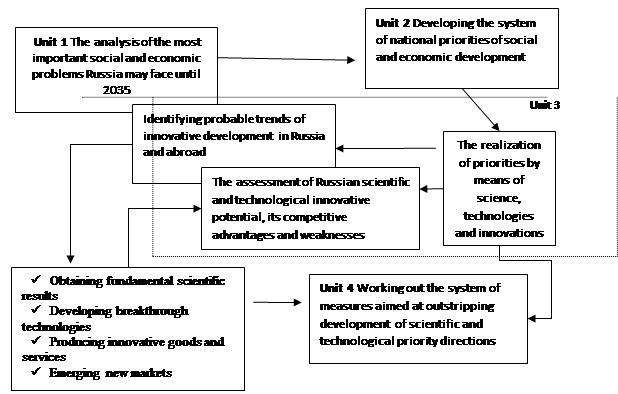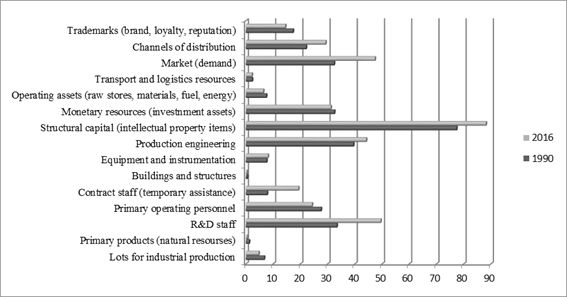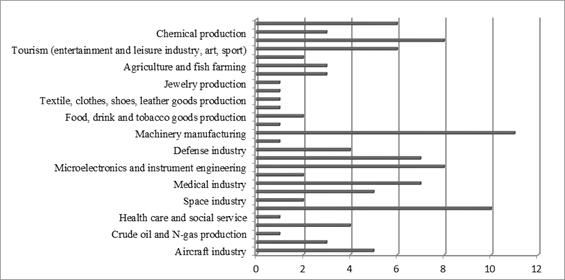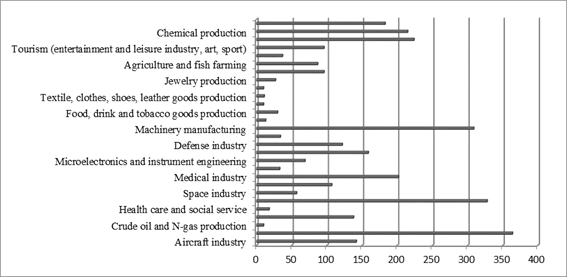Abstract
The primary object of developing the mechanism to identify directions of innovative activities (henceforth the mechanism) is to define a prospective horizon of innovative development: emerging markets enabling to embrace Russian research and technological capacities; prospective innovative technologies with a wide range of real-word applications. The problem of developing and supporting innovative development primarily needs an accurate vision of strategic prospects for innovative development in the context of defining potential markets and development trends; supporting breakthrough technologies; modernizing existing production when possible; stimulating and supporting private sector interest in investing innovative activities. The authors focus on peculiarities of developing and further accomplishing the mechanism to identify directions of innovative development based on high-tech business, which is due to the fact that exactly high-tech business is one of the key success factors to implement The National Technological Initiative (NTI) and achieve domestic product range competitiveness in the world market. The authors have conducted structural and dynamic analysis to define the main trends and significant factors of national innovative system development (henceforth NIS). The implementation of NTI project involves creating a universal platform for selecting breakthrough innovative projects and thereby developing new approaches. Currently the project office of the National Technological Initiative is the closest analogue of such a platform. Russian government fund and development institute launched the project office in order to implement pilot breakthrough projects at a single technological platform aiming at answering global challenges, but its first assessments showed the necessity to accomplish its mechanism.
Keywords: High-tech businessinnovationsinnovative developmentproject officetargeting
Introduction
The term ‘national innovative system’ was introduced by C. Freeman in 1982 (Freeman, 2004). Further, Lundvall (Lundvall, Johnson, Andersen, & Dalum, 2002) meant the whole of elements and relations interacting in producing, distributing and using new and commercially useful knowledge by the term ‘NIS’. The following research showed that NIS and its efficiency was relational rather that absolute: there could not be any ideal NIS suiting various countries with certain social, economic, political and cultural peculiarities (Edquist, 2001).
The efficiency of ‘catching-up’ or ‘imitative’ NIS was first mentioned in the 1960s (Gerschenkron, 1962).
The research showed that NIS is mostly imitative and is not able to create completely new developments and technologies. The proportion of Russian innovatively active enterprises lies within ten per cent (8.3 per cent), with the share of R&D expenditures at the cost of internal funds was above 67.5 per cent (engineering sciences) in 2015, though, the proportion of capital costs on R&D was no more than 6 per cent. The proportion of internal financing came to 100 per cent only in agricultural sciences (96.5 per cent).
Low scientific potential predetermines the existence and even efficiency of such a strategy of financing innovative activity. Nearly the same strategy of innovative cost allocation is in Slovakia and Cyprus. The Netherlands spend 62.5 per cent of all expenditures for innovations on staff research and development (17.6 per cent – made by outside companies), 19 per cent on acquisition of machinery and equipment. The same is specific to Denmark, Belgium, Sweden and other EU countries. The proportion of R&D expenditures may come to 80 per cent in countries with a higher innovative potential.
The study showed that domestic innovative system is currently based on the following principles for working out the mechanism of priority market development:
the creation of “piloting zones” mainly aimed at verifying, testing and certifying NTI competitive products, regulating their application (including standards development);
expanding NTI products usage initially through providing government contracts and procurements to state-owned companies;
policy framework transparency in global market;
supporting NTI goods and services export.
The organization of such a mechanism supposes cooperative work of three activity levels:
strategic (the activity of interdepartmental task forces);
operational – the activity of Russian federal executive bodies, Russian subjects, national research universities, development institutes;
tactical – model projects.
The significance of developing and accomplishing such a mechanism is a primary task, otherwise the budgeted investment volume into high-tech economic sector will be wasted: 12.46 billion rubles were budgeted for NTI projects in the 2017 federal budget. In 2018, 8.2 billion rubles were going to be spent on the NTI, with 8 billion rubles in 2019. Thus, the funding will reach 28.6 billion rubles in the next three years. At the end of 2016, six NTI roadmaps considering the use of new technologies in car industry, air transport, shipbuilding and water resources development, energy engineering, medicine, as well as in man-machine neurocommunication had been approved, as the Ministry of Education and Science representative said.
In turn, the priorities are specialized in 27 critical technologies being the most promising technological areas.
Problem Statement
The problem of identifying priorities for NIS development becomes crucial while formulating state policy. The sticking point of their definition is due to their twofold role: on the one hand, they should define the directions of state support, on the other hand, they should signal business on mutually beneficial solutions of national innovative competitiveness support problems while inviting to solve certain problems. The success in identifying priorities primarily depends on the quality of predictive research (Hekkert & Negro, 2007). Seemingly, the approach based on defining aims and strategic directions, determining specific parameters (indicators) and identifying resources is more advanced at the current stage in a context of transfer to post-industrial society and necessary competitive advantages of a domestic NIS. The authors note that at least three aspects are becoming obvious while establishing priorities for technological development, which complies with the methodology worked out by Gassler (Gassler, Polt, & Rammer, 2008) as recently as in 2008:
thematic. Urgent areas (technologies and fields) requiring immediate government intervention should be defined;
institutional. Procedure and criteria for priority selection supported by political institutions should be defined;
legitimate. Politicians and other key actors should reason attempted actions and final prioritizing.
Research Questions
While conducting a research, the authors have suggested a hypothesis on the necessity to develop a single complex mechanism of identifying NIS development trends within the framework of implementing NTI action items.
Purpose of the Study
The subject of the research is organizational and economic relations and management decisions of the mechanism in opening up prospective horizons of NIS innovative development.
Research Methods
The priority array of tools includes methods of benchmark assessment, analytical design, business environment study, dialectics, systemic approach.
The important instruments of developing the mechanism are Delphi method and foresight research aimed at long-term future (from the nearest till the distant one for 10-15 years), considering alternative development scenarios and concerning not only possible, probable and desirable happenings but the so-called wildcards – unlikely happenings possibly affecting the future of the researched sphere.
The informational platform used by the authors included databases, statistical reports and studies: Global Manufacturing Competitiveness Index (Craig, Rodriguez, Bharath, & Aleda, 2017); World Corporate Top R&D Investors (Daiko et al., 2015); World Bank databases (World Investment Report Investor Nationality: Policy Challenges, 2016), OECD (Education at a Glance 2016: OECD Indicators, 2016); competitiveness indices (Schwab & Sala-i-Martín, 2016).
Findings
Figure

The implementation of this mechanism implies coordinated functioning of four units.
Unit 1 involves the analysis of the most important social and economic problems Russia may face until 2035. The analysis of NIS competitive ability on new process technologies conducted by the authors suggests that Russian leadership in high-tech business may be hampered by several risks:
World technological leaders (the US, China, Japan and South Korea) have already laid scientific and technological groundwork for winning their leadership in global marketplace of current technological mode.
High proportion of Russian patents granted to non-residents may inhibit using new manufacturing processes for domestic production modernization.
Domestic patentees scarcely include large industrial companies possessing new industrial technologies patented in Russia or other countries.
The estimation of scientific, technological and innovative potential and the realization of priorities by means of science, technologies and innovations (unit 3) should contribute to solving the problem of identifying priorities of NIS further development (unit 2).
In order to assess innovative potential by means of science the authors have conducted a bibliographical research aimed at finding out the focus of retrospective scientific researches of high-tech economic sector. The statistical assessment of contributions over the time used main public bibliographical databases (Urait, Web of Science, EBSCO, E-Library, Scopus) focused on the economics of ‘high technologies’. The research resulted in the estimation of the number of indexed contributions, containing key words highlighting the interest in a productive factor or its compound (with account of morphology). The proportion of publications indexing a productive factor or its compound in a total amount is presented in relation to a time period (1990, 2016). The conducted bibliographical analysis enabled to identify the trends of forming research focus with reference to productive factors of high-tech industry (see Figure

The results of the study are definite in identifying key factors and resources of high-tech production sustainable developments (search for new markets and development of personnel involved into research and development) (Oveshnikova et al., 2018).
The result of the activity items within the previous units is accumulated in the fourth one aimed at first-hand development of measures system focused on creating conditions for outstripping development of priority scientific and technological directions, in a way that facilitates the NTI program.
The National Technological Initiative (NTI) – an umbrella programme including a wide range of different action items for government entities and subjects of innovative environment (small and medium-sized enterprises – SME, universities, venture community, etc.). Key instruments to coordinate the NIS in process – technology platforms (TP) and clusters, which are aimed at working out general projection of technological development prospects for a corresponding industry or technological direction, shaping and implementing long-range programme of research and development.
The authors found out that clusters are on their initial stage in most specializations, with high-level clusters in such specializations as ‘Nuclear and radiation technologies’, ‘Aircraft industry’, ‘Information and communication technologies’ and ‘Defense industry’. Namely one third of clusters (32.1 per cent) are included into ‘the list of pilot innovative territorial clusters’, with 51.4 per cent are supported by the center for cluster development. It is noted that the number of clusters by certain specializations as far as the average number of employed are sufficiently different in clusters. The following specializations are most presented by clusters: ‘Information and communication technologies’ (10 clusters, 328 participants with an average number of personnel of 369 workers), ‘Machinery manufacturing’ (11 clusters, 309 participants with an average number of personnel of 439 workers), ‘Microelectronics and instrument engineering’ (8 clusters, 69 participants with an average number of personnel of 1078 workers). However, in spite of multiplicity, only 2 clusters with high level development are registered among them.
Figure


The analysis showed that several cluster development programs do not incorporate created technology platforms (TP) which may serve an instrument to strengthen connections in clusters. Most cluster development programs refer to certain cluster organizations participating also in technology platforms, however, with minor exceptions, the advantage of such participation is not involved in cluster development programs. Almost 30 per cent of clusters do not mention any partnership with technology platforms in their development programs. However, most clusters are in high-tech business and in their infancy.
Currently NIS is operating in such a way that measures of TP and clusters support are interlinked, but cluster policy has been prioritized over. Meanwhile, Russian government offers the same approach to financing principles of both technology platforms and clusters. Clusters, as well as technology platforms, should cooperate with development institutes and work with state-owned companies implementing innovative development programs. The identity of financing principles is far from effective. Unfortunately, there has not been developed any ‘ideal’ mechanism of financial cooperation of innovative system elements. At the moment, only US and UK governments think their countries have created effective patterns of research and development state support, while governments in most other countries still continue accomplishing new patterns of financing research. Nevertheless, one may notice a common trend – shift away from traditional mechanisms of financing enterprises to the practice of competitive, thematically oriented financial support.
Conclusion
All of the aforesaid enabled to formulate certain recommendations concerning the development and accomplishment of the mechanism. It is obvious that the following action items should be realized:
developing the technology aimed at ‘opening’ NTI markets for promising goods and services created within NTI;
enacting the sampling procedure of ‘piloting zones’ for testing usage scenarios of most promising NTI goods and services, drafting regulatory documents standardizing their usage;
enacting the procedure of priority imbedding of successfully passed ‘piloting’ NTI goods and services into procurement for state and municipal purposes;
developing the mechanism of incubator / accelerator network for various development stages of NTI sectors companies;
enacting the mechanism of cluster participants incorporation into NTI working parties.
References
- Craig, A., Rodriguez, M., Bharath, G., & Aleda, V. (2017). Global Manufacturing Competitiveness Index. Retrieved September, 12, 2018, from https://www2.deloitte.com/lk/en/pages/manufacturing/articles/global-manufacturing-competitiveness-index.html.
- Daiko, T., Dernis, H., Dosso, M., Gkotsis, P., Squicciarini, M., & Vezzani, A. (2017). World Corporate Top R&D Investors: Industrial Property Strategies in the Digital Economy. A JRC and OECD common report. Luxembourg: Publications Office of the European Union.
- Edquist, C. (2001). Innovation policy – a systemic approach. In D. Archibugi and B.-A. Lundvall, eds. The globalizing learning economy (pp.219-238). Oxford: Oxford University Press.
- Education at a Glance 2016: OECD Indicators. (2016). Paris: OECD Publishing. DOI: 10.1787/eag-2016-en.
- Freeman, C. (2004). Technological infrastructure and international competitiveness. Industrial and Corporate Change. 13. 541-569.
- Gassler, H., Polt, W., & Rammer, C. (2008). Priority setting in technology policy. Historical developments and recent trends. In C. Nauwelaers & R. Wintjes (Eds.), Innovation Policy in Europe. Measurement and Strategy (pp. 203-224). Netherlands: Springer. DOI:
- Gerschenkron, A. (1962). Economic backwardness in historical perspective. Cambridge, MA: Harvard University Press.
- Hekkert, M.P. & Negro, S.O. (2007). Functions of innovation systems: a new approach for analyzing technological change. Technological Forecasting and Social Change, 74(4), 413-432.
- Lundvall, B.-Å., Johnson, B., Andersen, E.-S., & Dalum, B. (2002). National systems of production, innovation and competence building. Research Policy, 31, 213-231.
- Oveshnikova, L., Lebedinskaya, O., Timofeev, A., Mikheykina, L., Sibirskaya, E., Lula, P. (2018). Studying the sector of the Russian high-tech innovations on the basis of the global innovation index INSEAD. In E. G. Popkova, V. N. Ostrovskaya (Eds.), Perspectives on the Use of New Information and Communication Technology (ICT) in the Modern Economy (pp. 87-96). Cham: Springer. DOI:
- Schwab, K., & Sala-i-Martín, X. (2016). The Global Competitiveness Report. Retrieved September, 12, 2018, from http://reports.weforum.org/global-competitiveness-report-2015-2016.
- World Investment Report Investor Nationality: Policy Challenges. (2016). Retrieved September 12, 2018, from https://unctad.org/en/pages/PublicationWebflyer.aspx?publicationid=1555.
Copyright information

This work is licensed under a Creative Commons Attribution-NonCommercial-NoDerivatives 4.0 International License.
About this article
Publication Date
02 April 2019
Article Doi
eBook ISBN
978-1-80296-058-7
Publisher
Future Academy
Volume
59
Print ISBN (optional)
-
Edition Number
1st Edition
Pages
1-1083
Subjects
Business, innovation, science, technology, society, organizational theory,organizational behaviour
Cite this article as:
Lebedinskaya, O., Timofeev, A., & Kurnikova, M. (2019). Developing The Mechanism To Identify Directions Of Innovative Activities For Further Development. In V. A. Trifonov (Ed.), Contemporary Issues of Economic Development of Russia: Challenges and Opportunities, vol 59. European Proceedings of Social and Behavioural Sciences (pp. 198-205). Future Academy. https://doi.org/10.15405/epsbs.2019.04.23

